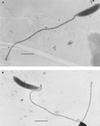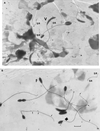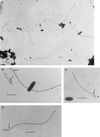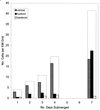In situ reproductive rate of freshwater Caulobacter spp
- PMID: 10966435
- PMCID: PMC92265
- DOI: 10.1128/AEM.66.9.4105-4111.2000
In situ reproductive rate of freshwater Caulobacter spp
Abstract
Electron microscope grids were submerged in Lake Washington, Seattle, Wash., in June 1996 as bait to which Caulobacter sp. swarmers would attach and on which they would then reproduce in situ. Enumeration of bands in the stalks of attached cells implied that the caulobacters were completing approximately three reproductive cycles per day. A succession of morphological types of caulobacters occurred, as well as an episode of bacteriovore grazing that slowed the accumulation of caulobacters and prevented the aging of the population.
Figures





References
-
- Bott T L, Brock T D. Growth and metabolism of periphytic bacteria: methodology. Limnol Oceanogr. 1970;15:333–342.
-
- Hirsch P. Budding bacteria. Annu Rev Microbiol. 1974;28:391–444. - PubMed
Publication types
MeSH terms
LinkOut - more resources
Full Text Sources
Miscellaneous

